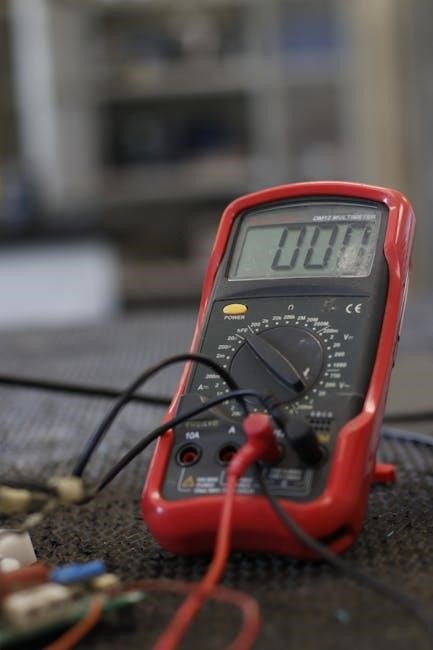electronic devices conventional current version 9th edition solution manual
The solution manual serves as a comprehensive guide for understanding electronic devices‚ offering detailed explanations and visual aids to enhance learning. It provides clear‚ step-by-step solutions to complex problems‚ emphasizing the Q-point’s role in transistor operation. This resource is invaluable for both students and educators‚ ensuring a thorough grasp of fundamental concepts and their practical applications in modern electronics.
1.1 Scope and Purpose of the Manual
The solution manual provides a detailed approach to understanding electronic devices‚ focusing on problem-solving and conceptual clarity. It covers fundamental topics like transistor operation‚ circuit analysis‚ and semiconductor materials. Designed for students and educators‚ the manual offers step-by-step solutions‚ worked-out examples‚ and practical explanations. Its primary purpose is to bridge the gap between theory and application‚ ensuring a deep understanding of electronic devices. The manual aligns with the textbook’s structure‚ offering comprehensive support for learning and teaching. It serves as an essential resource for mastering complex concepts in modern electronics.
1.2 Key Features of the 9th Edition
The 9th edition of the solution manual offers enhanced clarity and expanded coverage of key topics in electronic devices. It includes detailed worked-out examples‚ step-by-step solutions‚ and comprehensive explanations for complex problems. The manual provides expanded applications and troubleshooting techniques‚ making it a valuable resource for practical learning. With downloadable access‚ it ensures flexibility and convenience for users. The 9th edition aligns with modern electronics education‚ offering updated content and improved readability. Its structured approach supports both students and educators‚ making it an essential tool for mastering electronic devices and circuit theory.
1.3 Importance of the Q-Point in Transistor Operation
The Q-point‚ or quiescent operating point‚ is crucial in transistor operation as it establishes a stable DC operating condition. This fixed current and voltage level ensures optimal performance and minimizes signal distortion. By setting the Q-point‚ engineers can control the transistor’s behavior‚ enhancing reliability and efficiency in electronic circuits. Properly determining the Q-point is essential for achieving desired output in amplifiers and switches‚ making it a fundamental concept in electronic device analysis and design.

Core Concepts in Electronic Devices
This section explores fundamental principles of electronic devices‚ focusing on materials‚ current flow‚ and the differences between conductors and semiconductors. It builds the foundation for advanced topics.
2.1 Understanding Atoms and Materials in Electronics
Atoms are the foundation of electronic devices‚ with their structure determining material properties. Semiconductors‚ conductors‚ and insulators are classified based on atomic structure and electron mobility. The ninth edition emphasizes how these materials interact in electronic circuits‚ highlighting their role in current flow and device operation. Understanding these fundamentals is crucial for designing and analyzing electronic systems. The solution manual provides detailed explanations and examples to clarify these concepts‚ ensuring a strong grasp of the building blocks of modern electronics.
2.2 Current Flow in Semiconductors
Current flow in semiconductors is influenced by the movement of electrons and holes‚ which are positively charged gaps. Semiconductors exhibit intermediate conductivity‚ higher than insulators but lower than conductors. Doping introduces impurities‚ creating n-type (excess electrons) or p-type (deficit electrons) materials. The Q-point establishes a stable operating condition for transistors‚ balancing voltage and current. Understanding intrinsic and extrinsic semiconductors is vital for analyzing electronic circuits. The solution manual provides detailed examples and diagrams to clarify these principles‚ ensuring a solid foundation in semiconductor behavior and its role in modern electronic devices.
2.3 Conductors vs. Semiconductors: Key Differences
Conductors‚ like metals‚ exhibit high conductivity and low resistance‚ allowing electrons to flow freely. Semiconductors‚ such as silicon‚ have intermediate conductivity‚ with resistance varying based on temperature and doping. Unlike conductors‚ semiconductors can be modified to create n-type or p-type materials‚ enabling controlled current flow. This adaptability makes semiconductors crucial for electronic devices‚ while conductors are ideal for wiring and connections. The solution manual highlights these distinctions‚ providing examples and diagrams to clarify their roles in circuit design and functionality.

Circuit Analysis and Problem Solving
This section focuses on systematic approaches for analyzing electronic circuits‚ emphasizing problem-solving techniques and tools like equivalent circuits to simplify complex designs and enhance understanding.
3.1 Determining Threshold Voltage
Determining the threshold voltage is critical in understanding transistor operation. It involves identifying the minimum voltage required for the transistor to conduct current effectively. The solution manual provides step-by-step methods‚ including graphical and analytical approaches‚ to calculate this voltage. Key factors such as dopant concentration‚ temperature‚ and carrier mobility are discussed in detail. Practical examples and exercises help reinforce the concept‚ ensuring a solid foundation for circuit design and analysis. The manual also includes additional resources‚ such as downloadable PDF guides‚ to aid in mastering this fundamental concept.
3.2 Calculating Total Resistance in Circuits
Calculating total resistance in circuits is essential for analyzing and designing electronic systems. The solution manual provides clear methods for determining resistance in series‚ parallel‚ and complex circuits. Worked-out examples demonstrate how to apply Ohm’s Law and Kirchhoff’s Laws to find equivalent resistance. Step-by-step explanations ensure understanding of current flow and voltage distribution. Practical exercises and diagrams help reinforce the concepts‚ making it easier to solve real-world problems. The manual also includes tips for identifying common errors‚ ensuring accuracy in calculations and circuit analysis.
3.3 Thevenin and Norton Equivalent Circuits
The solution manual thoroughly explains Thevenin and Norton equivalent circuits‚ providing step-by-step methods to simplify complex circuits. Worked-out examples demonstrate how to calculate equivalent voltage and current sources. The manual highlights the conversion between Thevenin and Norton equivalents‚ ensuring a clear understanding of their applications. Practical exercises and diagrams illustrate how these circuits are used to analyze real-world electronic systems. The techniques provided enable accurate simplification of circuits‚ making it easier to solve for unknown voltages and currents in various configurations.

Applications and Troubleshooting
The manual includes expanded coverage of electronic device applications‚ practical troubleshooting techniques‚ and real-world case studies. It bridges theory with practical problem-solving‚ enhancing diagnostic and repair skills.
4.1 Expanded Coverage of Applications
The 9th edition solution manual provides an extensive exploration of electronic device applications across various fields. It covers topics such as power supplies‚ communication systems‚ and digital circuits‚ offering practical insights. The manual emphasizes real-world scenarios‚ enabling students to understand how theoretical concepts apply to everyday electronic systems. This expanded coverage ensures a deeper understanding of how electronic devices function in diverse environments‚ from consumer electronics to industrial control systems. The inclusion of modern applications prepares learners for current technological demands‚ making the manual a vital resource for both academic and professional settings.
4.2 Troubleshooting Techniques in Electronic Circuits
The 9th edition solution manual dedicates a section to troubleshooting techniques in electronic circuits‚ equipping learners with essential diagnostic skills. It presents a systematic approach to identifying and resolving circuit faults‚ emphasizing the use of multimeters and oscilloscopes for precise measurements. The manual also covers common failure modes and practical repair strategies‚ enhancing problem-solving abilities. By mastering these techniques‚ students gain confidence in analyzing and rectifying issues in complex electronic systems‚ aligning with real-world engineering practices.
4.3 Case Studies and Practical Examples
The 9th edition solution manual enhances learning through real-world case studies and practical examples‚ bridging theory and application. These scenarios cover various electronic circuits and devices‚ allowing students to analyze and solve problems in realistic contexts. The examples are designed to reinforce key concepts‚ such as transistor operation and circuit analysis‚ while encouraging critical thinking. By working through these case studies‚ learners gain practical insights and develop the ability to apply their knowledge to actual electronic systems‚ preparing them for hands-on challenges in their careers.

The Solution Manual Structure
The solution manual is organized to align with the textbook‚ providing clear chapter-by-chapter solutions‚ detailed explanations‚ and easy access to answers for all exercises and problems.
5.1 Chapter-by-Chapter Solutions
The solution manual offers detailed chapter-by-chapter solutions‚ aligning perfectly with the textbook. Each chapter provides clear explanations‚ step-by-step problem-solving‚ and practical examples to reinforce understanding. This structured approach ensures that students can follow along easily‚ referencing specific chapters for targeted learning. The manual includes worked-out problems‚ formulas‚ and key concepts‚ making it an essential resource for mastering electronic devices. Instructors and students alike benefit from this organized format‚ which complements the curriculum seamlessly. The chapter-by-chapter breakdown ensures comprehensive coverage of all topics‚ fostering a deeper grasp of the subject matter.
5.2 Worked-Out Examples and Explanations
The manual provides an extensive collection of worked-out examples‚ each accompanied by thorough explanations. These examples cover a wide range of topics‚ from basic transistor operation to complex circuit analysis. Detailed calculations and clear reasoning guide students through even the most challenging problems. Visual aids like diagrams and charts enhance understanding‚ while concise explanations ensure clarity. These worked-out examples not only reinforce theoretical concepts but also help students develop problem-solving skills. They serve as invaluable tools for self-study and review‚ enabling learners to grasp key ideas effectively and apply them in practical scenarios. This feature makes the manual an indispensable resource for both students and educators in the field of electronic devices.

5.3 Answers to Chapter Exercises
The solution manual includes comprehensive answers to all chapter exercises‚ ensuring students can verify their understanding of key concepts. Each answer is presented clearly and concisely‚ providing both numerical solutions and brief explanations. This feature helps students identify areas where they may need additional review. The answers are organized by chapter‚ making it easy to navigate and reference specific problems. By cross-referencing their work with the manual‚ learners can build confidence in their problem-solving abilities. This section is designed to support self-study and reinforce learning outcomes effectively.

Availability and Access
The solution manual is available for download in PDF format‚ ensuring easy access for students and educators. It can be accessed online through authorized platforms.
6.1 Downloadable Format and Accessibility
The solution manual is available in a downloadable PDF format‚ ensuring easy access for students and educators. It can be accessed online through platforms like the official publisher’s website or popular e-learning portals. The PDF format allows for compatibility with various devices‚ including desktops‚ laptops‚ tablets‚ and smartphones. Additionally‚ the manual is designed to be accessible‚ with features like searchable text and zoom capabilities for enhanced readability. This makes it convenient for users to study and reference the material anytime‚ anywhere‚ without the need for physical copies.
6.2 Instructions for Downloading the Manual
To download the solution manual‚ visit the official publisher’s website or authorized online platforms. Navigate to the “Resources” or “Support” section and select the 9th edition of Electronic Devices (Conventional Current Version). Follow the prompts to log in or create an account if required. Once logged in‚ locate the solution manual in the downloadable materials section and click the “Download” button. The file will be saved in PDF format‚ compatible with most devices. Ensure your device meets the system requirements for optimal viewing and accessibility.
6.3 System Requirements for Access
The solution manual is accessible on devices with compatible operating systems‚ including Windows‚ macOS‚ and Linux. A PDF viewer‚ such as Adobe Acrobat Reader‚ is required to open the file. Ensure your device has sufficient storage space and meets the minimum specifications for handling large documents. An internet connection is necessary for downloading the manual. For optimal viewing‚ a screen resolution of 1024×768 pixels or higher is recommended. Ensure your browser and software are updated to the latest versions for seamless access and functionality.

Instructor Resources
The solution manual offers downloadable resources for educators‚ including teaching materials and support tools to integrate the curriculum effectively. It provides comprehensive assistance for instructors to enhance teaching methods and student engagement.
7.1 Instructor Resource Information
The Instructor Resource Information provides educators with downloadable materials‚ including complete solutions‚ lecture slides‚ and teaching aids. These resources are designed to support instructors in delivering comprehensive lessons on electronic devices. The manual offers detailed explanations and visual guides to help educators clarify complex concepts. Additionally‚ instructors can access customizable materials to tailor their courses to specific needs. This section ensures that educators have all the necessary tools to effectively teach and engage students in understanding electronic devices and their applications.
7.2 Downloadable Resources for Educators
Educators can access a variety of downloadable resources‚ including lecture slides‚ test banks‚ and teaching guides‚ to support their instruction. These materials are designed to complement the solution manual and enhance classroom engagement. The resources are available in a secure‚ easily accessible format‚ ensuring convenience for instructors. They include detailed explanations‚ diagrams‚ and practical examples to aid in teaching complex topics. Additionally‚ educators can utilize these resources to create customized lesson plans tailored to their students’ needs‚ fostering a deeper understanding of electronic devices and their applications.
7.3 Supporting Materials for Teaching
The solution manual is complemented by a range of supporting materials designed to enhance teaching effectiveness. These include lecture slides‚ simulation labs‚ and assessment tools‚ providing instructors with a comprehensive toolkit. The materials are structured to align with the textbook’s content‚ ensuring seamless integration into course curricula. They also offer interactive elements and real-world examples‚ enabling educators to create engaging and practical learning experiences. These resources are regularly updated to reflect the latest advancements in electronic devices‚ ensuring relevance and accuracy in the classroom environment.

Updates in the 9th Edition
The 9th edition includes expanded coverage of applications‚ enhanced troubleshooting techniques‚ and improved explanations of key concepts to better align with modern teaching and learning needs.
8.1 Changes from the Previous Edition
The 9th edition incorporates significant enhancements‚ including expanded coverage of applications‚ improved troubleshooting techniques‚ and refined explanations of key concepts. These updates reflect feedback from users and educators‚ ensuring the manual remains relevant and effective. The structure has been streamlined for better clarity‚ with additional worked examples to aid comprehension. The focus on practical‚ real-world applications has been intensified‚ making it a valuable resource for both students and instructors. These changes underscore the commitment to providing a comprehensive and up-to-date learning tool in the field of electronic devices.
8.2 Expanded Coverage of Key Topics
The 9th edition delivers broader and deeper exploration of essential topics‚ with particular emphasis on transistor operation and circuit analysis. Expanded sections on applications and troubleshooting provide practical insights‚ while enhanced discussions on the Q-point and semiconductor materials offer foundational clarity. Additional worked examples and detailed explanations ensure a more comprehensive understanding of complex concepts. This expanded coverage addresses the evolving needs of students and educators‚ making the manual a more robust and versatile resource for mastering electronic devices and their applications in modern electronics.
8.3 Relevance of the 9th Edition in Modern Electronics
The 9th edition remains highly relevant in today’s rapidly evolving field of electronics‚ offering updated content that aligns with modern technological advancements. It bridges the gap between theoretical concepts and practical applications‚ making it indispensable for understanding contemporary electronic devices. The manual’s focus on problem-solving and real-world scenarios ensures it meets the demands of current engineering and technology curricula. By addressing emerging trends and applications‚ the 9th edition continues to be a vital resource for both students and professionals seeking to stay ahead in the dynamic world of electronics.
The 9th edition solution manual is a comprehensive resource for mastering electronic devices‚ offering clear explanations and practical examples to aid in understanding and problem-solving.

9.1 Summary of Key Benefits
The 9th edition solution manual offers comprehensive coverage of electronic devices‚ providing detailed explanations and practical examples; It enhances understanding of transistor operation‚ emphasizing the Q-point’s significance. With expanded troubleshooting and application sections‚ it bridges theory and practice effectively. The manual’s clarity and structured approach make it an invaluable resource for students and educators alike. Its downloadable format ensures accessibility‚ and the inclusion of instructor resources further supports teaching and learning. This edition is tailored to meet modern electronics demands‚ ensuring relevance and depth in its content.
9.2 Final Thoughts on the Solution Manual
The 9th edition solution manual is an indispensable resource for mastering electronic devices. It offers a wealth of knowledge‚ from fundamental concepts to advanced applications‚ ensuring a deep understanding of the subject. The manual’s structured approach‚ combined with its practical examples‚ makes it a valuable tool for both self-study and classroom instruction. Its relevance in modern electronics education is undeniable‚ providing students and educators with the support needed to excel. This edition is a testament to the evolution of electronic devices‚ delivering clarity and precision in every chapter.
